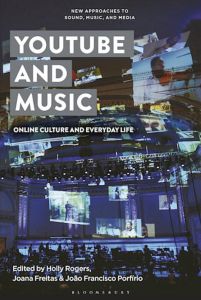Holly Rogers, Joana Freitas, João Francisco Porfírio (eds), YouTube and Music. Online Culture and Everyday Life, Bloomsbury Academic, 2023

With its 2005 launch, YouTube opened up new ways of presenting, distributing, and documenting musical creativity. As a platform, it affords low-threshold access to the manifold genres that populate contemporary musical life and simultaneously preserves past musical output. In the multi-author volume YouTube and Music. Online Culture and Everyday Life, edited by Holly Rogers, Joana Freitas, and João Francisco Porfírio, various contributors shed light on how record companies, musicians, and users take advantage of YouTube’s potential to support artists, stage performances, construct artistic (cyber-)identities, initiate interactive compositions, reorient music education, engage with the phenomenon of fandom, influence musical tourism, and quite generally set our everyday lives to music.
Happily, the mdw is represented in this volume with a contribution by Juri Giannini, a senior scientist at the Department of Musicology and Performance Studies. His chapter “‘Musical Personae’ 2.0: The Representation and Self-Portrayal of Music Performers on YouTube” is positioned within the volume’s first section, entitled “Transmedia, Performance and Digital Stages”. This section is comprised of four chapters that examine how performers and composers put YouTube’s characteristics to use in the interest of exploiting new musical possibilities. Giannini presents a case study on the Uzbekistan-born American pianist Lola Astanova, who not only maintains a strong social media presence but is also controversially discussed on account of her sexualized self-presentation. In this study, Philip Auslander’s theoretical engagement with musicians’ strategies of presentation and representation—consisting of “the real person (the performer as human being)”, “the performance persona (the performer as social being)”, and “the character”—proves valuable. Employing Auslander’s theoretical toolbox, Giannini identifies a new type of “musical persona” being designed by contemporary “digital musicians” and describes fragments of a theory of “musical selfies” via which performers can exploit new forms of liveness and identity. This novel type of the “digital musician”, argues Giannini, affects the methods and approaches via which we musicologists and historians will be researching contemporary performance practice in the future.
The volume’s broad-based team of authors, hailing from the fields of musicology, film studies, philosophy, media theory, cultural geography, and psychology, show by way of their case studies how YouTube can be a central component of contemporary musical culture, a space for collaborative musical work, and a place for the reordering and creative destruction of genre-hierarchies and musical canons. And incidentally, one way in which these topics’ explosive nature can be discerned is the mode of this volume’s release: as an open access publication, YouTube and Music. Online Culture and Everyday Life can be obtained and reused free of charge.

